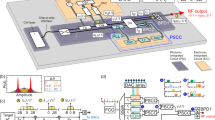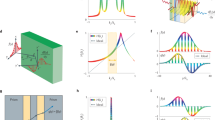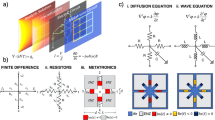Abstract
The rapid growth in artificial intelligence and modern communication systems demands innovative solutions for increased computational power and advanced signalling capabilities. Integrated photonics, leveraging the analogue nature of electromagnetic waves at the chip scale, offers a promising complement to approaches based on digital electronics. To fully unlock their potential as analogue processors, establishing a common technological base between conventional digital electronics and analogue photonics is imperative for building next-generation computing and communications systems. However, the absence of an efficient interface has thus far critically challenged a comprehensive demonstration of the advantages of analogue photonic hardware, with the scalability, speed and energy consumption as primary bottlenecks. Here we address this challenge and demonstrate a general electro-optic digital-to-analogue link enabled using foundry-based lithium niobate nanophotonics. Using purely digital electronic inputs, we achieve the on-demand generation of both analogue optical and electronic waveforms at information rates of up to 186 Gb s−1. The optical waveforms address the digital-to-analogue electro-optic conversion challenge in photonic computing, showcasing high-fidelity Modified National Institute of Standards and Technology image encoding with an ultralow power consumption of 0.058 pJ b−1. The electronic waveforms enable a pulse-shaping-free microwave arbitrary waveform generation method with ultrabroadband tunable delay and gain. Our results pave the way for efficient and compact digital-to-analogue conversion paradigms enabled by integrated photonics, and underscore the transformative impact that analogue photonic hardware may have on various applications, such as computing, optical interconnects and high-speed ranging.
This is a preview of subscription content, access via your institution
Access options
Access Nature and 54 other Nature Portfolio journals
Get Nature+, our best-value online-access subscription
$32.99 / 30 days
cancel any time
Subscribe to this journal
Receive 12 print issues and online access
$259.00 per year
only $21.58 per issue
Buy this article
- Purchase on SpringerLink
- Instant access to full article PDF
Prices may be subject to local taxes which are calculated during checkout




Similar content being viewed by others
Data availability
All data needed to evaluate the conclusions of the paper are available within the Article and its Supplementary Information.
References
LeCun, Y., Bengio, Y. & Hinton, G. Deep learning. Nature 521, 436–444 (2015).
Winzer, P. J., Neilson, D. T. & Chraplyvy, A. R. Fiber-optic transmission and networking: the previous 20 and the next 20 years. Opt. Express 26, 24190–24239 (2018).
Graves, A. et al. Hybrid computing using a neural network with dynamic external memory. Nature 538, 471–476 (2016).
Akopyan, F. et al. TrueNorth: design and tool flow of a 65 mW 1 million neuron programmable neurosynaptic chip. IEEE Trans. Comput. Aided Des. Integr. Circuits Syst. 34, 1537–1557 (2015).
Chen, X. et al. All-electronic 100-GHz bandwidth digital-to-analog converter generating PAM signals up to 190 GBaud. J. Lightwave Technol. 35, 411–417 (2017).
Song, H.-J. & Lee, N. Terahertz communications: challenges in the next decade. IEEE Trans. Terahertz Sci. Technol. 12, 105–117 (2022).
Miller, D. A. B. Attojoule optoelectronics for low-energy information processing and communications. J. Lightwave Technol. 35, 346–396 (2017).
Wetzstein, G. et al. Inference in artificial intelligence with deep optics and photonics. Nature 588, 39–47 (2020).
Shastri, B. J. et al. Photonics for artificial intelligence and neuromorphic computing. Nat. Photonics 15, 102–114 (2021).
Capmany, J. & Novak, D. Microwave photonics combines two worlds. Nat. Photonics 1, 319–330 (2007).
Marpaung, D., Yao, J. & Capmany, J. Integrated microwave photonics. Nat. Photonics 13, 80–90 (2019).
McMahon, P. L. The physics of optical computing. Nat. Rev. Phys. 5, 717–734 (2023).
Marković, D., Mizrahi, A., Querlioz, D. & Grollier, J. Physics for neuromorphic computing. Nat. Rev. Phys. 2, 499–510 (2020).
Rashidinejad, A., Li, Y. & Weiner, A. M. Recent advances in programmable photonic-assisted ultrabroadband radio-frequency arbitrary waveform generation. IEEE J. Quantum Electron. 52, 1–17 (2016).
Bogaerts, W. et al. Programmable photonic circuits. Nature 586, 207–216 (2020).
Shu, H. et al. Microcomb-driven silicon photonic systems. Nature 605, 457–463 (2022).
Zhang, M., Wang, C., Kharel, P., Zhu, D. & Lončar, M. Integrated lithium niobate electro-optic modulators: when performance meets scalability. Optica 8, 652–667 (2021).
Xu, M. et al. Dual-polarization thin-film lithium niobate in-phase quadrature modulators for terabit-per-second transmission. Optica 9, 61–62 (2022).
Patel, D., Samani, A., Veerasubramanian, V., Ghosh, S. & Plant, D. V. Silicon photonic segmented modulator-based electro-optic DAC for 100 Gb/s PAM-4 generation. IEEE Photonics Technol. Lett. 27, 2433–2436 (2015).
Dubé-Demers, R., LaRochelle, S. & Shi, W. Low-power DAC-less PAM-4 transmitter using a cascaded microring modulator. Opt. Lett. 41, 5369–5372 (2016).
Simard, A. D., Filion, B., Patel, D., Plant, D. & LaRochelle, S. Segmented silicon MZM for PAM-8 transmissions at 114 Gb/s with binary signaling. Opt. Express 24, 19467–19472 (2016).
Huynh, T. N. et al. Flexible transmitter employing silicon-segmented Mach–Zehnder modulator with 32-nm CMOS distributed driver. J. Lightwave Technol. 34, 5129–5136 (2016).
Samani, A. et al. Experimental parametric study of 128 Gb/s PAM-4 transmission system using a multi-electrode silicon photonic Mach Zehnder modulator. Opt. Express 25, 13252–13262 (2017).
Sobu, Y. et al. High-speed optical digital-to-analog converter operation of compact two-segment all-silicon Mach–Zehnder modulator. J. Lightwave Technol. 39, 1148–1154 (2021).
Jafari, O., Zhalehpour, S., Shi, W. & LaRochelle, S. DAC-less PAM-4 slow-light silicon photonic modulator providing high efficiency and stability. J. Lightwave Technol. 39, 5074–5082 (2021).
Wang, C. et al. Integrated lithium niobate electro-optic modulators operating at CMOS-compatible voltages. Nature 562, 101–104 (2018).
Hu, Y. et al. On-chip electro-optic frequency shifters and beam splitters. Nature 599, 587–593 (2021).
Hu, Y. et al. Integrated electro-optics on thin-film lithium niobate. Nat. Rev. Phys. 7, 237–254 (2025).
Zhang, M., Wang, C., Cheng, R., Shams-Ansari, A. & Lončar, M. Monolithic ultra-high-Q lithium niobate microring resonator. Optica 4, 1536–1537 (2017).
Zhu, X. et al. Twenty-nine million intrinsic Q-factor monolithic microresonators on thin-film lithium niobate. Photonics Res. 12, A63–A68 (2024).
Zhou, H. et al. Photonic matrix multiplication lights up photonic accelerator and beyond. Light Sci. Appl. 11, 30 (2022).
Cundiff, S. T. & Weiner, A. M. Optical arbitrary waveform generation. Nat. Photonics 4, 760–766 (2010).
Wang, J. et al. Reconfigurable radio-frequency arbitrary waveforms synthesized in a silicon photonic chip. Nat. Commun. 6, 5957 (2015).
Tan, M. et al. Photonic RF arbitrary waveform generator based on a soliton crystal micro-comb source. J. Lightwave Technol. 38, 6221–6226 (2020).
Fischer, B. et al. Autonomous on-chip interferometry for reconfigurable optical waveform generation. Optica 8, 1268–1276 (2021).
Cox, C. H., Ackerman, E. I., Betts, G. E. & Prince, J. L. Limits on the performance of RF-over-fiber links and their impact on device design. IEEE Trans. Microw. Theory Tech. 54, 906–920 (2006).
Kharel, P., Reimer, C., Luke, K., He, L. & Zhang, M. Breaking voltage–bandwidth limits in integrated lithium niobate modulators using micro-structured electrodes. Optica 8, 357–363 (2021).
St-Arnault, C. et al. Net 3.2 Tbps 225 Gbaud PAM4 O-band IM/DD 2 km transmission using FR8 and DR8 with a CMOS 3 nm SerDes and TFLN modulators. Preprint at https://arxiv.org/abs/2503.24147 (2025).
Della Torre, A. et al. Folded electro-optical modulators operating at CMOS voltage level in a thin-film lithium niobate foundry process. Opt. Express 33, 6747–6757 (2025).
Xue, S. et al. Full-spectrum visible electro-optic modulator. Optica 10, 125–126 (2023).
Renaud, D. et al. Sub-1 Volt and high-bandwidth visible to near-infrared electro-optic modulators. Nat. Commun. 14, 1496 (2023).
He, L. et al. Low-loss fiber-to-chip interface for lithium niobate photonic integrated circuits. Opt. Lett. 44, 2314–2317 (2019).
Liu, X. et al. Ultra-broadband and low-loss edge coupler for highly efficient second harmonic generation in thin-film lithium niobate. Adv. Photonics Nexus 1, 016001 (2022).
Cheng, R. et al. Single-drive electro-optic frequency comb source on a photonic-wire-bonded thin-film lithium niobate platform. Opt. Lett. 49, 3504–3507 (2024).
Franken, C. A. A. et al. High-power and narrow-linewidth laser on thin-film lithium niobate enabled by photonic wire bonding. APL Photonics 10, 026107 (2025).
Zeng, B. et al. Cryogenic packaging of nanophotonic devices with a low coupling loss <1 dB. Appl. Phys. Lett. 123, 161106 (2023).
Assumpcao, D. et al. A thin film lithium niobate near-infrared platform for multiplexing quantum nodes. Nat. Commun. 15, 10459 (2024).
Botez, D., Garrod, T. & Mawst, L. J. High CW wallplug efficiency 1.5 micron-emitting diode lasers. In 2015 IEEE Photonics Conference (IPC) 551–552 (IEEE, 2015); https://doi.org/10.1109/IPCon.2015.7323726
Mashanovitch, M. et al. High-power, efficient DFB laser technology for RF photonics links. In 2018 IEEE Avionics and Vehicle Fiber-Optics and Photonics Conference (AVFOP) 1–2 (IEEE, 2018); https://doi.org/10.1109/AVFOP.2018.8550469
Jin, W. et al. Hertz-linewidth semiconductor lasers using CMOS-ready ultra-high-Q microresonators. Nat. Photonics 15, 346–353 (2021).
Yu, M. et al. Integrated electro-optic isolator on thin-film lithium niobate. Nat. Photonics 17, 666–671 (2023).
Xiang, C. et al. 3D integration enables ultralow-noise isolator-free lasers in silicon photonics. Nature 620, 78–85 (2023).
Guo, X. et al. High-performance modified uni-traveling carrier photodiode integrated on a thin-film lithium niobate platform. Photonics Res. 10, 1338–1343 (2022).
Shams-Ansari, A. et al. Electrically pumped laser transmitter integrated on thin-film lithium niobate. Optica 9, 408–411 (2022).
Lin, Z. et al. 120 GOPS Photonic tensor core in thin-film lithium niobate for inference and in situ training. Nat. Commun. 15, 9081 (2024).
Hu, Y. et al. Integrated lithium niobate photonic computing circuit based on efficient and high-speed electro-optic conversion. Preprint at https://arxiv.org/abs/2411.02734 (2024)
Nahmias, M. A. et al. Photonic multiply-accumulate operations for neural networks. IEEE J. Sel. Top. Quantum Electron. 26, 1–18 (2020).
Shen, Y. et al. Deep learning with coherent nanophotonic circuits. Nat. Photonics 11, 441–446 (2017).
Gupta, S., Agrawal, A., Gopalakrishnan, K. & Narayanan, P. Deep learning with limited numerical precision. In Proc. 32nd International Conference on Machine Learning Vol. 37 (eds Bach, F. & Blei, D.) 1737–1746 (PMLR, 2015).
DeepSeek-AI et al. DeepSeek-V3 technical report. Preprint at https://arxiv.org/abs/2412.19437 (2025).
Dettmers, T. & Zettlemoyer, L. The case for 4-bit precision: k-bit inference scaling laws. In Proc. 40th International Conference on Machine Learning Vol. 202 (eds Krause, A. et al.) 7750–7774 (PMLR, 2023).
Hamerly, R., Bernstein, L., Sludds, A., Soljačić, M. & Englund, D. Large-scale optical neural networks based on photoelectric multiplication. Phys. Rev. X 9, 021032 (2019).
Chen, Z. et al. Deep learning with coherent VCSEL neural networks. Nat. Photonics 17, 723–730 (2023).
Ou, S. et al. Hypermultiplexed integrated photonics-based optical tensor processor. Sci. Adv. 11, eadu0228 (2025).
Hu, Y. et al. High-efficiency and broadband on-chip electro-optic frequency comb generators. Nat. Photonics 16, 679–685 (2022).
Song, Y., Hu, Y., Zhu, X., Yang, K. & Lončar, M. Octave-spanning Kerr soliton frequency combs in dispersion- and dissipation-engineered lithium niobate microresonators. Light Sci. Appl. 13, 225 (2024).
Song, Y., Zhu, X., Zuo, X., Huang, G. & Lončar, M. Stable gigahertz- and mmWave-repetition-rate soliton microcombs on X-cut lithium niobate. Optica 12, 693–701 (2025).
Xu, X. et al. 11 TOPS photonic convolutional accelerator for optical neural networks. Nature 589, 44–51 (2021).
Bai, B. et al. Microcomb-based integrated photonic processing unit. Nat. Commun. 14, 66 (2023).
Chen, Z. et al. Efficient erbium-doped thin-film lithium niobate waveguide amplifiers. Opt. Lett. 46, 1161–1164 (2021).
Zhou, J. et al. On-chip integrated waveguide amplifiers on erbium-doped thin-film lithium niobate on insulator. Laser Photon. Rev. 15, 2100030 (2021).
Jia, Y. et al. Integrated photonics based on rare-earth ion-doped thin-film lithium niobate. Laser Photon. Rev. 16, 2200059 (2022).
Cardenas, J. et al. Wide-bandwidth continuously tunable optical delay line using silicon microring resonators. Opt. Express 18, 26525–26534 (2010).
Koenig, S. et al. Wireless sub-THz communication system with high data rate. Nat. Photonics 7, 977–981 (2013).
Pfeifle, J. et al. Coherent terabit communications with microresonator Kerr frequency combs. Nat. Photonics 8, 375–380 (2014).
Marin-Palomo, P. et al. Microresonator-based solitons for massively parallel coherent optical communications. Nature 546, 274–279 (2017).
Rizzo, A. et al. Massively scalable Kerr comb-driven silicon photonic link. Nat. Photonics 17, 781–790 (2023).
Siddharth, A. et al. Ultrafast tunable photonic-integrated extended-DBR Pockels laser. Nat. Photonics 19, 709–717 (2025).
Xue, S. et al. Pockels laser directly driving ultrafast optical metrology. Light Sci. Appl. 14, 209 (2025).
Ghelfi, P. et al. A fully photonics-based coherent radar system. Nature 507, 341–345 (2014).
Zhu, S. et al. Integrated lithium niobate photonic millimetre-wave radar. Nat. Photonics 19, 204–211 (2025).
Liu, W. et al. A fully reconfigurable photonic integrated signal processor. Nat. Photonics 10, 190–195 (2016).
Feng, H. et al. Integrated lithium niobate microwave photonic processing engine. Nature 627, 80–87 (2024).
Maity, S. et al. Coherent acoustic control of a single silicon vacancy spin in diamond. Nat. Commun. 11, 193 (2020).
Riedel, D. et al. Efficient photonic integration of diamond color centers and thin-film lithium niobate. ACS Photonics 10, 4236–4243 (2023).
Knaut, C. M. et al. Entanglement of nanophotonic quantum memory nodes in a telecom network. Nature 629, 573–578 (2024).
Menssen, A. J. et al. Scalable photonic integrated circuits for high-fidelity light control. Optica 10, 1366–1372 (2023).
Christen, I. et al. An integrated photonic engine for programmable atomic control. Nat. Commun. 16, 82 (2025).
Acknowledgements
We thank K. Richard, N. Hoffman, M. Roberts and Keysight Technologies, Inc. for technological support, J. Jacobson for assistance and D. Plant and G. Hills for discussions. This work is supported by the Korea Advanced Institute of Science and Technology, grant number NRF-2022M3K4A1094782 (to Y.S., Y.H. and X.L.), the Defense Advanced Research Projects Agency, grant number HR001120C0137 (to Y.H. and L.M.), the National Science Foundation (NSF), grant numbers OMA-2137723 (to Y.H.), NSF 2138068 (to Y.H.) and NSF EEC-1941583 (to K.P., H.K.W. and N.S.), the Department of the Navy, grant number N6833522C0413 (to X.Z. and K.P.), Amazon Web Services (AWS), grant number A50791 (to K.P., L.M. and D.R.), DRS Daylight Solutions, Inc., award A56097 (to L.M.), NASA grant number 80NSSC22K0262 (to N.S.), the National Institutes of Health, grant numbers NIH P41EB015903 (to N.L. and B.V.) and NIH R21EY031895 (to N.L. and B.V.) and the Singapore National Research Foundation grant numbers NRF2022-QEP2-01-P07 and NRF-NRFF15-2023-0005 (to D.Z.). Y.S. acknowledges support from the AWS Generation Q Fund at the Harvard Quantum Initiative. L.M. acknowledges support from the Capes-Fulbright and Behring Foundation fellowships. H.K.W. acknowledges support from the National Science Foundation Graduate Research Fellowship Program. S.L. acknowledges support from the A*STAR National Science Scholarship. The views, opinions and/or findings expressed are those of the authors and should not be interpreted as representing the official views or policies of the Department of Defense or the US Government.
Author information
Authors and Affiliations
Contributions
M.L. and Y.H. conceived the project. Y.S. and Y.H. designed the experiments. Y.S. performed the measurements and analysed the data with Y.H. assisting. Y.H. led the foundry tapeout with F.Y. assisting. X.Z., Y.S. and Y.H. fabricated the early versions of the device. K.P., L.M., H.K.W., S.L., X.L., D.R., N.L., D.Z., B.V., M.Z. and N.S. helped with the project. Y.S., Y.H. and M.L. wrote the manuscript with contributions from all authors. M.L. supervised the project.
Corresponding authors
Ethics declarations
Competing interests
F.Y., D.R., M.Z. and M.L. are involved in developing lithium niobate technologies at HyperLight Corporation. The remaining authors declare no competing interests.
Peer review
Peer review information
Nature Photonics thanks Jose Capmany, Charles Roques-Carmes and the other, anonymous, reviewer(s) for their contribution to the peer review of this work.
Additional information
Publisher’s note Springer Nature remains neutral with regard to jurisdictional claims in published maps and institutional affiliations.
Supplementary information
Supplementary Information
Supplementary Discussion and Figs. 1–5.
Rights and permissions
Springer Nature or its licensor (e.g. a society or other partner) holds exclusive rights to this article under a publishing agreement with the author(s) or other rightsholder(s); author self-archiving of the accepted manuscript version of this article is solely governed by the terms of such publishing agreement and applicable law.
About this article
Cite this article
Song, Y., Hu, Y., Zhu, X. et al. Integrated electro-optic digital-to-analogue link for efficient computing and arbitrary waveform generation. Nat. Photon. 19, 1107–1115 (2025). https://doi.org/10.1038/s41566-025-01719-9
Received:
Accepted:
Published:
Issue date:
DOI: https://doi.org/10.1038/s41566-025-01719-9



